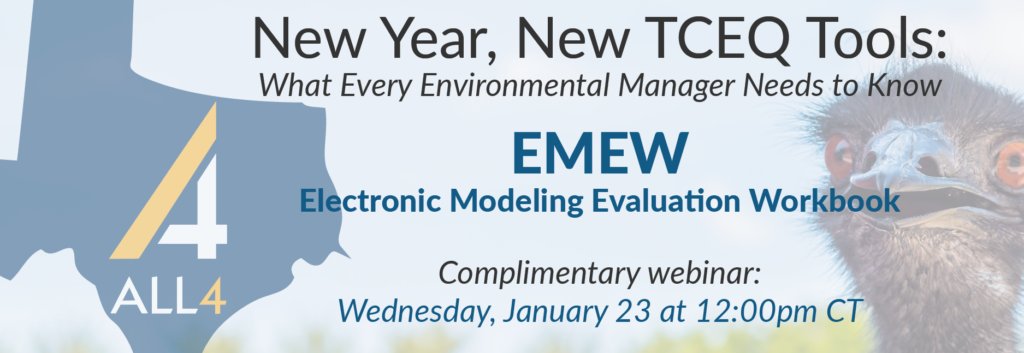TCEQ Unveils New Tool to Streamline Air Quality Modeling
Posted: November 19th, 2018
Authors: Dan D.
A theme of the Texas Commission on Environmental Quality (TCEQ) Autumn Conference (Conference) held on October 9th and 10th was the introduction of air permitting “tools” designed to streamline the air permitting process for both TCEQ and permit applicants. These “tools” extended all the way into the air quality modeling arena with the roll out of the Electronic Modeling Evaluation Workbook (EMEW). The intention behind the EMEW is to take the place of an Air Quality Analysis (AQA) report and an air quality modeling protocol as well as require applicants to provide all the necessary information in a standard format with none of the “fluff”. The EMEW is a Microsoft Excel-based workbook that contains tabs for modeling related options that are required as part of minor New Source Review (NSR) permitting in TX. The EMEW closely follows TCEQ’s APDG 6232 Guidance Document (i.e., Air Quality Modeling Guidelines) that was recently updated (September 2018) to incorporate amendments to 40 CFR Part 51, Appendix W (The Guideline on Air Quality Models). However, as even TCEQ admitted at the conference, there is no regulatory basis for the requirement to submit an EMEW in place of a tradition AQA report.
Conversation at the Conference centered around another “request” of TCEQ related to the use of the EMEW. TCEQ is requesting that an EMEW be submitted with a minor NSR permit application including “preliminary” air quality modeling results starting June 1, 2019 in lieu of an AQA Report or air quality modeling protocol. Anybody that has worked on air quality modeling knows that submitting air quality modeling results with what essentially qualifies as an air quality modeling protocol, is not the usual flow of an air quality modeling project. Typically, an air quality modeling protocol is submitted to gain approval of the emissions calculations and technical approach used in the air quality modeling analysis. Submittal of results with the initial EMEW and minor NSR application will inevitably lead to additional modeling runs if the TCEQ finds any revisions that are necessary as part of their review of the EMEW and minor NSR application. TCEQ’s justification for submittal of preliminary modeling results with the EMEW is to identify any “project stoppers” or major project changes that would be required to demonstrate compliance with applicable air quality modeling standards before time is spent reviewing the minor NSR application.
However, as an optimistic person, hopefully any additional time spent utilizing the new EMEW will be offset by less back and forth with TCEQ and not having to develop a AQA report. For this reason, I applaud TCEQ’s efforts to streamline the air permitting process and look forward to utilizing the EMEW on my next air quality modeling project. For permit applicants my recommendation is to plan ahead and expect to address the detailed emissions source characteristics for your next project even earlier in the process. If you have any questions about the EMEW or would like ALL4 to assist with your next air quality modeling project, please reach out to me at (281) 937-7553 extension 118 or ddix@all4inc.com.


